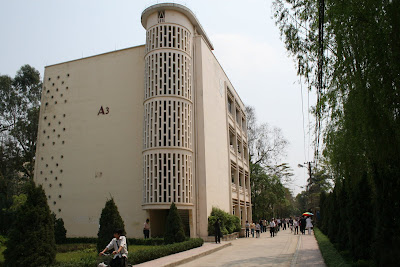
SO, I'm in the midst of this Fulbright research mishagas. I came with the intention of studying monuments and memorials in Vietnam, then I came across this line:
"In fact, by universal standards, Hanoi does not have any great individual monuments."
I feel like it should be the tagline of this blog. Anyway, I've shifted my focus (for both conscientious and arbitrary reasons) to the architecture of Hanoi's national universities. Many of them date from the 1960's and 1970's, in a critical period of national identity formation. None of those words have too much meaning, and I'm weary that a great cloud of vagueness and
consequent boringness will descend on this my baby-blog. That is why I am using this innovative and tedious format to work and think small. Still, introductions were in order.
Today's topic:
http://www.nytimes.com/2008/06/08/magazine/08shenzhen-t.html?ref=design

This is an article by Nicolai Ouroussoff, the architecture critic of the New York Times. He's very smart. Ideologically I think he is more committed to his strain of modernist utopianism than I am. He's always raving about the importance of new building and reifying a progressive spirit for New York, which I support, but sometimes I think he forgets about things like dislocation and poor people. He quotes Steven Holl, who said, "[Americans have] become too backward-looking. In China, they want to make everything look new. This is their moment in time. They want to make the 21st century their century. For some reason, our society wants to make everything old. I think we somehow lost our nerve.” Sounds like someone we know . . .
This article is about the building boom in Shenzhen, China. Basically in Shenzhen as in many fast growing cities in the developing world there is a scale of expansion which is totally without precedent. The great challenge is to build on this monumental scale while preserving something of the "fine grain" that older cities possess. This "fine grain" occurs organically on a smaller scale, where more actors over more time build more slowly. The opposite of this "fine grain" is something like a Modernist skyscraper: perfect, geometric, inhuman, and endlessly and speedily (or not) replicable. Ouroussoff is questioning the possibilities of some way of building massively without building inhumanly.
Right now I'm interested in how a similar tension between a kind of modernist, a-particular, utopianism and a nationalist, indigenous, Vietnamese-ness were realized in the massive building projects of the 1960's and 1970's.

Again, thinking small: some choice thoughts on modernism in Asia:
"Some of the modern typologies work in Asia even though they are totally dysfunctional in America. Typologies we’ve rejected turn out to be viable in other contexts"
-Rem Koolhaas and a possible explanation from Steven Holl:
"But what makes it possible is the density. The Modernist idea of the street in the air that became a place of social interaction never worked in Europe. Beijing is so dense that I can keep all of the shops functioning on the street, and there’s still enough energy to activate the bridges as well."
The ideal here is maybe best expressed by Zaha Hadid:
"We wanted to create a complex order rather than either the monotony of Modernism or the chaos you find in contemporary cities."
I'm not an architect or a self-styled expert and my main concern is really about the ideology and historical memory expressed in built spaces so I'll limit myself to a few observations.
1. The idea that a locality and particular culture (here, Asian) might itself be more amenable to some Modernist built form itself challenges that troublesome form of modernism whose origin lies in an Enlightenment idea of "Man."
I mean the strain of thought which suggests that Man and his life can be measured objectively, his perfect life apprehended, and his perfect space realized. The idea of "Man-s" moves away from this idea. This suggests another modernism which is not incongruous with "Asian" culture (always more problems, am I right?, but one step at a time).
2. The observation that city life can be extended upwards or manipulated differently in Vietnam strikes me as true. That density is real. Also, the way public and private space are so different really does allow city life (vague, I know) to extend to spaces that I imagine being empty, creepy, and dangerous in America.
3. The question of precedent and scale is interesting, but I'll blog on that later.

No comments:
Post a Comment